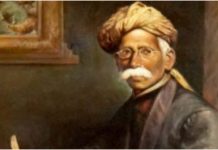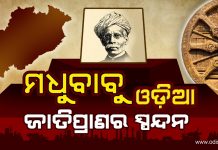CHRONOLOGY

1568: Orissa, a powerful empire (for a period of one thou-sand years) till the middle part of sixteenth century lost its independence. Being dismembered it was an annexed to the adjoining states of Bengal, Bihar, Madhya Pradesh and Madras.
1765: South Orissa was occupied by the East India Company (part of Madras Presidency).
1803: North Orissa (the main heart land), was occupied by the East India Company (part of Bengal Presidency). Western Orissa (part of Madhya Pradesh).
1848: Madhusudan Das born at Satyabhamapur village in the district of Cuttack in Orissa (28-04-1848) as the son of Raghunath Das, a Persian knowing pleader – mother Parvati Devi, a lady of deep compassion and strong determination.
1860: Prosecuted studies in the Cuttack Govt. High school. Passed Entrance (Matriculation) Examination in 1864.
1866: (i) After a brief service career at Balasore, left for Calcutta by steamer from Chandbali Port. At Calcutta prosecuted studies with much hardship. (ii) Orissa under the severe grip of deadliest famine of the century stripping away one-fourth of the population of Orissa (Naanka Durvikhya).
1870: Graduated from the Calcutta University.
1873: Passed M.A. (English) – Married to Soudamini Devi of Calcutta – Acclaimed as a successful English teacher.
1874: Published the book, “Model questions” for students.
1875: Organised a Labour Union at Matiabruz (Calcutta) and organised a night school for the workers.
1878: Qualified in Law – Started practicing in the law courts of Calcutta – Associated with Cultural and political life of Calcutta – Joined with Surendra Nath Banarjee (Indian Association) – Established contact with W.C.Banarjee and other founding fathers of Indian National Congress (1884-1885) – Untimely death of his wife Soudamini Devi (1878).
1881: Returned to Cuttack – Joined the bar as one of the outstanding lawyers – Associated with cultural life and Press at Cuttack, particularly with Gouri Sankar Ray, editor of the Utkal Dipika.
1882: Organised the Orissa Association (Utkal Sabha) the premier nationalist organisation of the state for cultural and economic resurgence and for the merger of Oriya speaking areas.
1883: Joined as honorary law lecturer (part-time) till 1890.
1884: Organised Odissi and Classical musical nights as a part of cultural resurgence.
1886: Attended the second session of A.I.C.C. at Calcutta.
1887: Conducted the famous Jagannath temple case – Established the first sophisticated permanent stage for drama at Cuttack – As vice-president of Cuttack District Board took initiative in spreading of primary education and athletic training in rural schools.
1888: Concerted efforts for establishing railway lines in the East Coast (Orissa) – Agitation for removal of salt tax – Established cordial relationship between Hindus and Muslims through ‘Fouzi Ama’ Organisation.
1893: Committed determination for his exclusive use of Swadeshi Goods – A precursor of Swadeshi Industrial Movement.
1894: Preliminary arrangements for establishment of Orissa Artwares, the first Swadeshi industrial undertaking – Laying of railway lines in Eastern Coasts (Orissa) started.
1895: Abolition of Oriya, as the court Language from Central Province (Sambalpur) – Strong protest – Submission of memorandum with the viceroy of India – published six articles on language problem of Western Orissa.
1896: Elected to the Bengal Legislative Council till 1912 with a short break in between.
1897: Left for London – Met the Secretary of State for India, George Hamilton and placed the demand on behalf of Oriya speaking people – At London organised the first Swadeshi Industrial exhibition – Pleaded for protective tarrif cover for Indian industries.
1898: Successful functioning of Orissa Art Wares – Established the first co-operative society of India, the Cuttack co-operative store.
1899: As a champion for Swadeshi Movement launched a powerful campaign for exclusive and committed use of country made goods – Obtained pledges from the conscious citizens in this respect.
1900: Met Lord Curzon, the Viceroy of India and effectively and emotionally placed demand for merger of Oriya speaking areas – On his invitation Lord Curzon visited temple cities of Orissa (Puri & Bhubaneswar), taking the advantage of first railway link to Orissa – Lord Curzon pledged for the preservation of the ancient monuments and for redressing the grievances of Oriya speaking people.
1901: Met Lord Curzon for restoration of Oriya as court language in the Sambalpur district.
1902: Historic meeting of Oriya leaders at Rambha.
1903: (i) Re-introduction of Oriya language in Sambalpur district (01-01-1903). (ii) Conference of Oriya leaders at Berhampur (12-04-1903). (iii) Issue of Risley Circular of Govt. of India for according approval for the proposal of the merger of Oriya speaking areas (03-12-1903). (iv) Holding of historic 1st session Utkal Sammilani presided over by Ma-haraja Sri Ramchandra Bhanjadeo (30-12-1903) – Establish-ment of Utkal Sahitya Samaja and Orissa Chhatra Sammilani (1903).
1904: Conferring of C.I.E. title – Establishment of premier athletic association of the state – ‘Orissa Sports Association’ & ‘Orissa Youngmens’ Association’.
1905: (i) Establishment of export-oriented leather industry of the country, Utkal tannery providing gainful employment to untouchables in the sphere of Swadeshi Industrial undertaking. (ii) Merger of Sambalpur district, Kalahandi, Patna, Sonepur, Rairakhol, Bamara (from Madhya Pradesh), Gangpur and Bonai (from Bihar) to Orissa division, on 16-10-1905.
1907: (i) Second visit to England – Met Lord Morely, Secretary of State – published the book, “Unrest in India” – Re-turned to Orissa, participated in relief operations in the flood affected areas. (ii) Arranged scholarships for Oriya students studying in Calcutta – The scholarships were availed by the prominent Oriya leaders during their student career. (iii) Emotionally associated with ‘Vande Mataram’ movement of Sri Aurobindo – established closer contacts.
1909: Organised a widely based labour organisation at Calcutta, including a night school.
1912: Elected to the Bihar & Orissa Legislative council till 1924. (i) Fought valiantly for the protection of rights of the peasants of Orissa in the Bengal legislative council – Creation of Bihar and Orissa province. (ii) Establishment of Praja Parishad (the first peasants organisation) – Delivered presidential address in the Bihari students’ conference. Attended A.I.C.C. session at Patna.
1913: Elected as the member of Central (Viceroys) Legislative Council till 1917.
1914: Holding of historic Utkal Sammilani at Paralakemendi organised by Maharaja Krushna Chandra Gajapati – published patriotic songs.
1915: Held the post of the President of All India Christian Association for three annual terms till 1917 (2nd to 4th session).
1916: Started legal practice in the Patna High Court.
1917: Submitted memorandum before Mont-Ford Commission at Calcutta. Edited the paper ‘Oriya’, an English weekly.
1918: Holding of annual conference of all India Christian Association at Cuttack.
1919: Presided in the All Orissa Chattra Sammilani at Puri.
1920: First meeting with Mahatma Gandhi at Calcutta. -Associated with Chittaranjan Das, in his political career. Brought Chttaranjan Das and Mahatma Gandhi closer. Launching of Non-cooperation movement by Mahatma Gandhi at Nagpur.
1921: Joined as the Minister of Bihar & Orissa Government under Mont-Ford Reforms (Diarchy).
1923: (i) Promulgation of Local Self-Govt. Act for Bihar and Orissa. (ii) Conferring rights to women of India to practice as lawyers in the legal courts of India. (iii) Resignation from the post of Ministership.
1924: Gave evidence before Philiph-Duff Committee. Delivering speech on ‘Dignity of labour’ at Patna. Meeting with Gandhiji at Sabaramati Ashram at Ahmedabad.
1925: Mahatma Gandhi visited Utkal Tannery on 19-8-1925 at Cuttack as the Guest of M.S. Das. Mahatma Gandhi was deeply moved by the enormity of the endeavour for rehabilitation of untouchables through establishment of tannery – Successful tanning of the skins of dead cattle as a significant measure for protection of the cows. His residential house was put to auction (25-10-1925).
1927: Declared insolvent (4-8-1927). Mahatma Gandhi vis-ited Cuttack and stayed at his residence (18th to 21st December 1927).
1928: Visit of statutory commission to Patna on 12-12-1928. Submission of Memorandum.
1929: Visited Jamshedpur along with Netaji Subhas Chan-dra Bose and restructured labour unions.
1930: Submission of report by Attlee sub-committee for creation of the state of Orissa.
1931: Visit of Maharaja K.C. Gajapati to London for attending Round Table Conference – setting up Boundary (O’Donnell) Committee for Orissa. Gave reception to the Boundary (O’Donell) committee at his residence at Cuttack – gave evidence before the committee.
1933: (i) Last momentous address to the Oriya speaking people on 12-02-1933. (ii) At his instance, Maharaja visited England to finalise the creation of the Orissa province. (2nd May 1933). (iii) Final declaration of creation of Orissa State. (24-9-1933) (iv) Participated as a member in the Orissa Administrative Committee.
1934: Passes away on 4.2.1934 – Tributes and homage paid. 1936: Creation of the new state of Orissa on 1st April, 1936.
(Courtesy: ‘Madhusudan Das: The Pride of The Nation’ by Surasinha Patnaik)

















